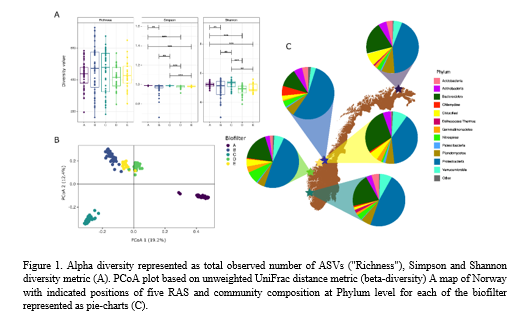HOW UNIQUE OR COMMON ARE MICROBIAL COMMUNITIES IN BIOFILTERS? A TALE OF STATE-OF-THE-ART LONG-TERM MONITORING OF INDUSTRIAL RECIRCULATING AQUACULTURE SYSTEMS
Introduction
At present, microbiological analyses used for detection of microorganisms in biofilter are mainly limited to the detection of total bacteria, nitrifiers or certain potentially problematic representatives. Although nitrifying microorganisms are a very important component for the performance of a biofilter in RAS, these are not the only microorganism group in such a complex ecosystem. In this study, we have employed 16S rRNA gene amplicon sequencing on samples derived from five different full industrial scale RAS over a period of fifteen months to elucidate microbiota dynamics during standard production period and to investigate how different or common are microbial communities in different RAS systems. This study obtains data at an unprecedented immensity and longitudinal depth reported so far.
Materials and methods
Biofilters of five different RAS farms farming Atlantic salmon ( Salmo salar) have been monitored over a period of fifteen months. Monitored farms, and corresponding biofilters, exhibit different designs, but also characteristics . Samples from each biofilter were collected bi-monthly and in triplicates . DNA was extracted, amplified (V3-V4 16S rDNA region), and sequenced using Illumina MiSeq platform . Obtained sequences were treated using Quantitative Insights Into Microbial Ecology 2 (QIIME2) pipeline. Downstream statistical analysis was performed in R using dedicated packages for microbiome analysis and multivariate statistics.
Results and discussion
Biofilters showed differences in regard to alpha diversity (Simpson and Shannon index) . As seen from figure 1A. the smallest variations in diversity were observed for biofilters in farms A and C. Also, biofilters A and C showed significantly higher Simpson and Shannon diversity when compared to microbial diversity observed in biofilters B, D and E. This is also an indication that the most stable bacterial communities can be found in biofilters A and C. Principal Coordinate Analysis (PCoA ) of microbial communities revealed unique microbial fingerprint for each of biofilters (Figure 1B). The clustering distance coincides also with geographical locations of the respective RAS farms, meaning that biofilters A and C are to be found on completely opposite sides of Norway, while biofilters B, D and E are geographically much closer. It has been hypothesized that each RAS biofilter (and RAS in general) has the potential to establish a unique microbial composition or "fingerprint" due to different operational procedures, components or design1 . Exact explanation for the differences in microbial community, as for within and between biofilters, are rather inconclusive here as many different variables could have accounted for that. All farms investigated for this study are very different in biofilter design, capacity, maturity, day-to-day operations, disinfection methods and frequency, and even the fish rearing stages. However, there is an indication that geographical origin of water used to fill the systems and uniqueness of RAS itself could have played a substantial role as a driving force for shaping microbial community composition and subsequent maturation, as observed in Figure 1B and Figure 1C.
Most dominating phyla were Proteobacteria with relative abundance ranging from 38.1% up to 55.3% (Figure 1C). Proteobacteria were followed by Bacteroidetes, with 13.8% to 28.2% in relative abundance. Other phy la that showed abundances larger than 2 % were Plantomycetes , Cloroflexi , Verrucomicrobia , Actinobacteria, Acidobacteria , Nitrospirae , Chlamydiae , Chlorofexi and Gemmatimonadetes . Similar observations were obtained by Huang et al.2 and Ruan et al.3 where most dominant phyla in monitored biofilters were Proteobacteria, followed by Bacteroidetes, Nitrospirae , Planctomycetes, Actinobacteria, Chlorofelxi and Verrucomicrobia. Although beta-diversity analysis showed rather unique microbial composition between biofilters, there is an indication that certain microbial groups are omnipresent in monitored biofilters. To investigate this further, we have screened for common microbiota of all five biofilters. Interestingly few genera found to represent core microbiota are already well-known nitrifiers, i.e., Nitrospira and Nitrosomonas. For the other taxa found within the core microbiome, literature overview shows that these microbes are commonly found in wastewater and activated sludge, but also other RAS biofilters, where they demonstrated ability for the hydrolysis and utilization of complex carbon sources.
Conclusions
In this study we have conducted deep and comprehensive mapping of microbial communities and their dynamics in biofilters of five full scale commercial RAS cultivating Atlantic salmon. Large differences in microbial communities and heir dynamics could be observed between monitored biofilters. Although, microbiologically different, core common microbiota could be established, with known nitrifiers representing it amongst other taxa.
References
1. Blancheton , J. P., Attramadal, K. J. K., Michaud, L., d’Orbcastel, E. R. and Vadstein, O. (2013). "Insight int o bacterial population in aquaculture systems and its implication." Aquacultural Engineering 53: 30-39.
2. Huang, Z., Wan, R., Song, X., Liu, Y., Hallerman , E., Dong, D., Zhai, J., Zhang, H. and Sun, L. (2016). "Metagenomic analysis shows diverse, distinct bacterial communities in biofilters among different marine recirculating aquaculture systems." Aquaculture international 24(5): 1393-1408.
3. Ruan, Y.-J., Guo, X.-S., Ye, Z.-Y., Liu, Y. and Zhu, S.-M. (2015). "Bacterial community analysis of different sections of a biofilter in a full-scale marine recirculating aquaculture system." North American Journal of Aquaculture 77(3): 318-326.
